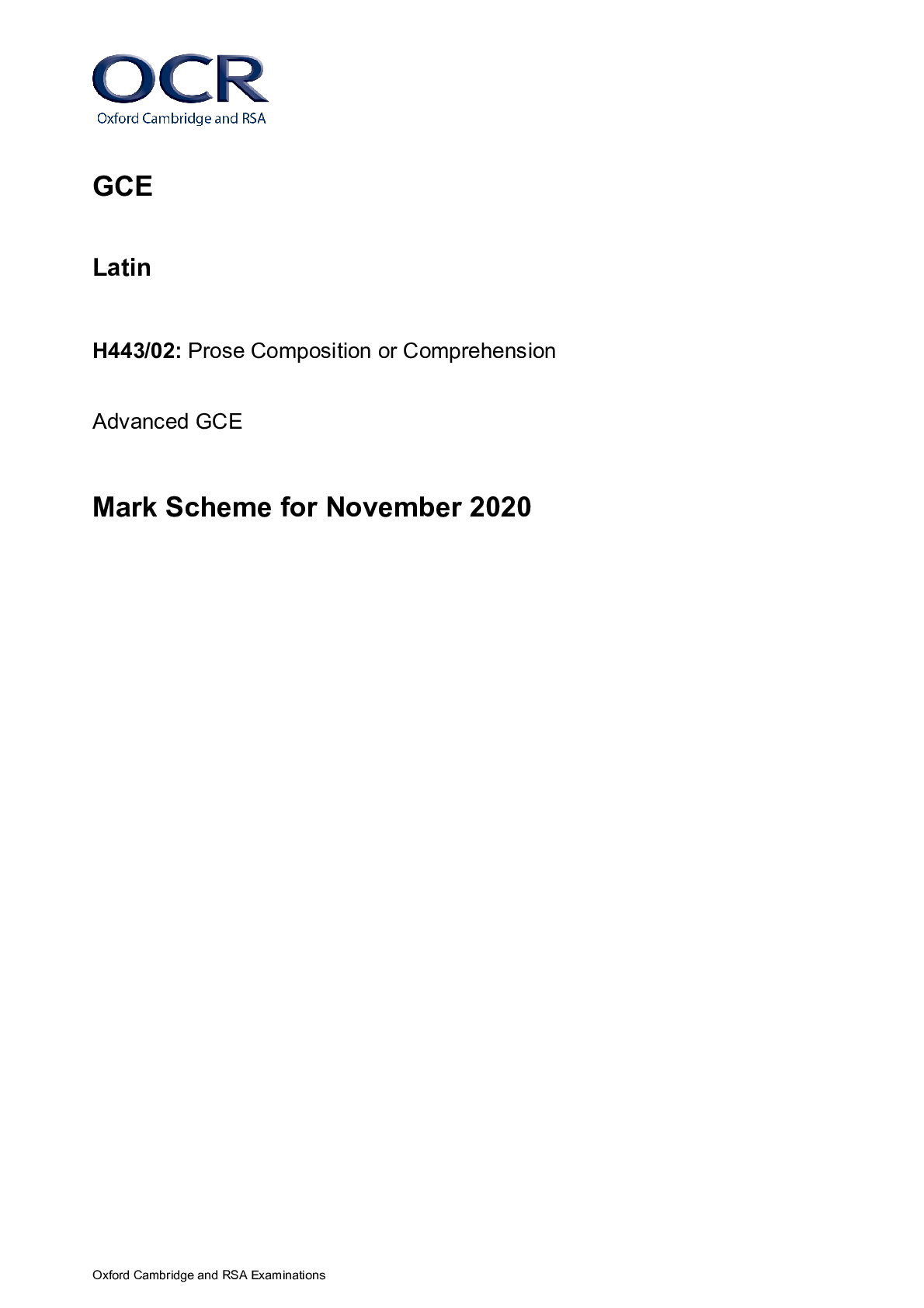Chemistry > GCSE MARK SCHEME > GCE Chemistry B (Salters) H433/03: Practical skills in chemistry Advanced GCE Mark Scheme for Autumn (All)
GCE Chemistry B (Salters) H433/03: Practical skills in chemistry Advanced GCE Mark Scheme for Autumn 2021
Document Content and Description Below
GCE Chemistry B (Salters) H433/03: Practical skills in chemistry Advanced GCE Mark Scheme for Autumn 2021 Oxford Cambridge and RSA Examinations GCE Chemistry B (Salters) H433/03: Practical skill... s in chemistry Advanced GCE Mark Scheme for Autumn 2021Oxford Cambridge and RSA Examinations OCR (Oxford Cambridge and RSA) is a leading UK awarding body, providing a wide range of qualifications to meet the needs of candidates of all ages and abilities. OCR qualifications include AS/A Levels, Diplomas, GCSEs, Cambridge Nationals, Cambridge Technicals, Functional Skills, Key Skills, Entry Level qualifications, NVQs and vocational qualifications in areas such as IT, business, languages, teaching/training, administration and secretarial skills. It is also responsible for developing new specifications to meet national requirements and the needs of students and teachers. OCR is a not-for-profit organisation; any surplus made is invested back into the establishment to help towards the development of qualifications and support, which keep pace with the changing needs of today’s society. This mark scheme is published as an aid to teachers and students, to indicate the requirements of the examination. It shows the basis on which marks were awarded by examiners. It does not indicate the details of the discussions which took place at an examiners’ meeting before marking commenced. All examiners are instructed that alternative correct answers and unexpected approaches in candidates’ scripts must be given marks that fairly reflect the relevant knowledge and skills demonstrated. Mark schemes should be read in conjunction with the published question papers and the report on the examination. © OCR 2021H433/03 Mark Scheme October 2021 2 1. Annotations available in RM Assessor Annotation Meaning Correct response Incorrect response Omission mark Benefit of doubt given Contradiction Rounding error Error in number of significant figures Error carried forward Level 1 Level 2 Level 3 Benefit of doubt not given Noted but no credit given IgnoreH433/03 Mark Scheme October 2021 3 2. Abbreviations, annotations and conventions used in the detailed Mark Scheme (to include abbreviations and subject-specific conventions). Annotation Meaning / alternative and acceptable answers for the same marking point Separates marking points DO NOT ALLOW Answers which are not worthy of credit IGNORE Statements which are irrelevant ALLOW Answers that can be accepted ( ) Words which are not essential to gain credit __ Underlined words must be present in answer to score a mark ECF Error carried forward AW Alternative wording ORA Or reverse argumentH433/03 Paper D Mark Scheme October 2021 4 9 Question Answer Mark AO Guidance 1 (a) Tollens’ reagent/Ammoniacal silver (nitrate) or red / orange (precipitate/solid) 4 1.2 2.1,2.1 2.3 ALLOW misspellings that are clearly meant to be Tollens e.g. Tollings Not silver nitrate alone, but allow ammoniacal silver nitrate/silver nitrate + ammonia ALLOW one mark if two correct structural (but not skeletal) formulae used ALLOW colour change on its own 1 (b) (butan-2-ol is) secondary; Secondary: two ‘R’ groups/ carbon atoms OR (only)1 hydrogen attached to the C with the OH 2 2.5 1.2 1 (c) CH3 CH3 C CH3 OH CH3 CH3 C CH3 O CH3 CH3 C CH3 CH3 CH3 C CH3 Cl H H H+ Cl _ - H2O Each arrow 2 2 x 2.1 Arrows should start at bond/lone pair and finish at + ve charge. If extra arrows any extra are a CON of one mark.H433/03 Paper D Mark Scheme October 2021 5 10 1 (d) Please refer to the marking instructions on page 5 of this mark scheme for guidance on how to mark this question. Level 3 (5 – 6 marks) Detailed instructions on how to separate chloroalkane and remove all impurities. Including most of fine detail There is a well-developed line of reasoning which is clear and logically structured. The information presented is relevant and substantiated. Level 2 (3 – 4 marks) Detailed instructions (with most of fine detail) on two of main procedural techniques OR general instructions on at least three (i.e. little fine detail but all main procedures discussed) There is a line of reasoning presented with some structure. The information presented is relevant and supported by some evidence. Level 1 (1 – 2 marks) General instructions on at least one area with little or no fine detail There is some attempt at a logical structure with a line of reasoning. The information present is in the most part relevant. Level 0 (no marks) No response or no response worthy of credit 6 3.3(x3) 3.4(x3) Indicative scientific points may include: Main points and (fine detail) Separation transfer to separating funnel (chloroalkane will form top layer) run off lower aqueous layer ALLOW pipette off top organic layer Removal of acid impurities shake organic product with sodium hydrogen carbonate solution (ALLOW sodium carbonate solution) (add small volumes at a time) (release pressure of CO2) (keeping adding until no effervescence) Removal of water transfer upper/organic layer to conical flask add anhydrous sodium sulfate/calcium chloride/magnesium sulfate/other suitable drying agent (swirl mixture) (decant off liquid) Obtaining pure chloroalkane distillation collect liquid at boiling point of product Total 14H433/03 Paper D Mark Scheme October 2021 6 11 Question Answer Mark AO Guidance 2 (a) primary - sequence/order of amino acids secondary (folding of 1y structure into) {β} (sheet) and {α} (helices) tertiary - folding of secondary structure/ sheets and helices 3 3 x 1.1 NOT chain Mention of α and β - BOD mark ALLOW 3D structure of (entire) protein / overall structure 2 (b) i dashed line is bond/part of molecule going behind/into plane of paper/faces backwards wedge bond/part of molecule coming out/in front of plane of paper/faces forwards 1 1.1 Both explanations required to score mark 2 (b) ii O O O O NH2 _ _ H2N O O _ 2 2 x 2.7 2 (c) i a part of a molecular structure that is responsible for a particular biological or pharmacological/medicinal activity/AW 1 1.1 2 (c) ii C OH H R2 R1 C OH R2 H R1 chiral - asymmetric/a part of structure giving rise to asymmetry enantiomers - non-superimposable mirror images 3 1.1 2.1 2.2 ALLOW any correct object and mirror image. ALLOW dotted lines instead of dotted wedges. ALLOW etc If there are two ordinary lines (as opposite) they must not be at 180o to each other. ALLOW carbon with 4 different groups/atoms attached. Read other as different. NOT just cannot be superimposedH433/03 Paper D Mark Scheme October 2021 7 12 2 (c) iii active sites also chiral cannot interact/fit with receptor/active sites 2 2 x 3.2 Mark separately ORA 2 (d) first order only initially/lower substrate concentration because rate proportional to concentration graph flattens, zero order at high 3 3 x 3.2 CHECK graph, answer sometimes written there Total 15 Question Answer Ma rk AO Guidance 3 (a) i Cl2 + 2I– → I2 + 2Cl– 1 2.5 IGNORE state symbols; must be balanced (a) ii purple: solution of iodine in cyclohexane brown: solution of iodine in water/aqueous solution of iodine 1 3.1 Use of ions CONS mark ALLOW I3- (aq) 3 (b) i CHECK ANSWER ON ANSWER LINE If answer = 144 mg, award 4 marks mole S2O32- = 0.0142 x 0.001 = 1.42 x 10-5 mole I2 from 25 cm3 = above ÷ 2 = 0.71 x 10-5 total moles of iodide in 25 cm3 = 0.71 x 10–5 x 4 = 2.84 x 10-5 concentration =above x 40 = 1.136 x 10-3 mol dm-3 mg dm-3 = above x 126.9= 0.1442g = 144 mg dm-3 to 3sf’s 4 3 x 2.4 3.1 ALLOW ecf at all stages Look for /0.025 instead of x 40 If not 3sf - CON 3 (b) ii S oxidation state changes from +2 to +2½ increase in oxidation state/number is oxidation 2 2 x 2.8 3 (c) Iodine: (diatomic) (small) molecule Potassium iodide: (giant) ionic (lattice) Polar water molecules attracted to +ve and -ve ions in KI Little interaction/id-id with non-polar iodine molecule and water 4 1.2 2.1 2.1 2.2 ALLOW simple aka ‘small’ Total 12H433/03 Paper D Mark Scheme October 2021 8 13 Question Answer Mark AO Guidance 4 (a) (i) [H+] = √Ka x [propanoic acid] = √ 1.3 x 10-5 x 0.5 = 2.55 x 10-3 pH = -log above = 2.59/2.6 (not 2.5) 2 2 x 3.1 4(a)(i), 4(a)(ii) and 4(c) need pH as answer (ii) conc HCl = 20 x 0.05/50 = 0.02 pH = -log above = 1.7, so correct 2 2 x 3.1 Second mark dependent on first being scored (ecf based on pH = -log[H+} only allowed once (i.e. on 4a(i) } (b) C2H5COO– + H2O ⇌ C2H5COOH + OH- C2H5COO- (accepting protons/H+ therefore) behaving as an base conjugate acid propanoic acid (molecule) 3 1.2 2.5 2.6 ALLOW structural formulae ALLOW with Na+ Must have ⇌ (c) amount C2H5COONa = 2.4/96 = 0.025 mol [H+] = Ka x [acid] [salt] (AW) [H+] = 1.3 x 10–5 x either mole ratio 0.015/0.025 or concentration ratio 0.5/0.833 = 7.8 x 10–6, so pH = 5.1 4 4 x 3.2 Do not allow ecf if already used on 4(a) Allow with values in H+ expressionH433/03 Paper D Mark Scheme October 2021 9 14 4 (d)* Please refer to the marking instructions on page 4 of this mark scheme for guidance on how to mark this question. Level 3 (5 – 6 marks) Selects mixture as buffer (and not other two) with most ‘choice’ points. Adds most explanation points with most equations. There is a well-developed line of reasoning which is clear and logically structured. The information presented is relevant and substantiated. Level 2 (3 – 4 marks) Selects mixture (and not other two) as buffer with some choice points and some explanation points There is a line of reasoning presented with some structure. The information presented is relevant and supported by some evidence. Level 1 (1 – 2 marks) Not clear which is buffer but gives some relevant points from choice and explanation/equations OR Selects mixture as buffer and gives some other relevant points There is some attempt at a logical structure with a line of reasoning. The information present is in the most part relevant. Level 0 (no marks) No response or no response worthy of credit 6 2 x 3.1 2 x 1.2 2 x 2.2 Indicative scientific points may include: Choice of buffer solution (AO3.1) Mixture/Solution C is buffer since it resists changes in pH on: addition of small amounts of acid addition of small amounts of alkali dilution Acid and Base/salt not buffers since vary when changed as above. Explanation of how a buffer works (AO1.2/2.2) C6H5COOH reacts with any added hydroxide ions C6H5COOH + OH- ⇌ C6H5COO- + H2O C6H5COO- reacts with any added H+ ions C6H5COO- + H+ ⇌ C6H5COOH maintains pH if conc. of conjugate acid and base both large. [H+] = Ka x [acid] [salt] All these for mixture, only first two for acid and base separatelyH433/03 Paper D Mark Scheme October 2021 10 15 e amines are proton/H+ acceptors OR lone pair of electrons on N 2 1.1 2.1 base as proton acceptor / electron pair donator proton/ H+ acceptor shown by equation second mark for idea that it is lone pair on N atom that can form (dative) bond to H+ Total 19OCR (Oxford Cambridge and RSA Examinations) The Triangle Building Shaftesbury Road Cambridge CB2 8EA OCR Customer Contact Centre Education and Learning Telephone: 01223 553998 Facsimile: 01223 552627 Email: general.qualifications@ocr.org.uk [Show More]
Last updated: 2 years ago
Preview 1 out of 12 pages

Buy this document to get the full access instantly
Instant Download Access after purchase
Buy NowInstant download
We Accept:

Reviews( 0 )
$7.00
Can't find what you want? Try our AI powered Search
Document information
Connected school, study & course
About the document
Uploaded On
Oct 07, 2022
Number of pages
12
Written in
Additional information
This document has been written for:
Uploaded
Oct 07, 2022
Downloads
0
Views
113

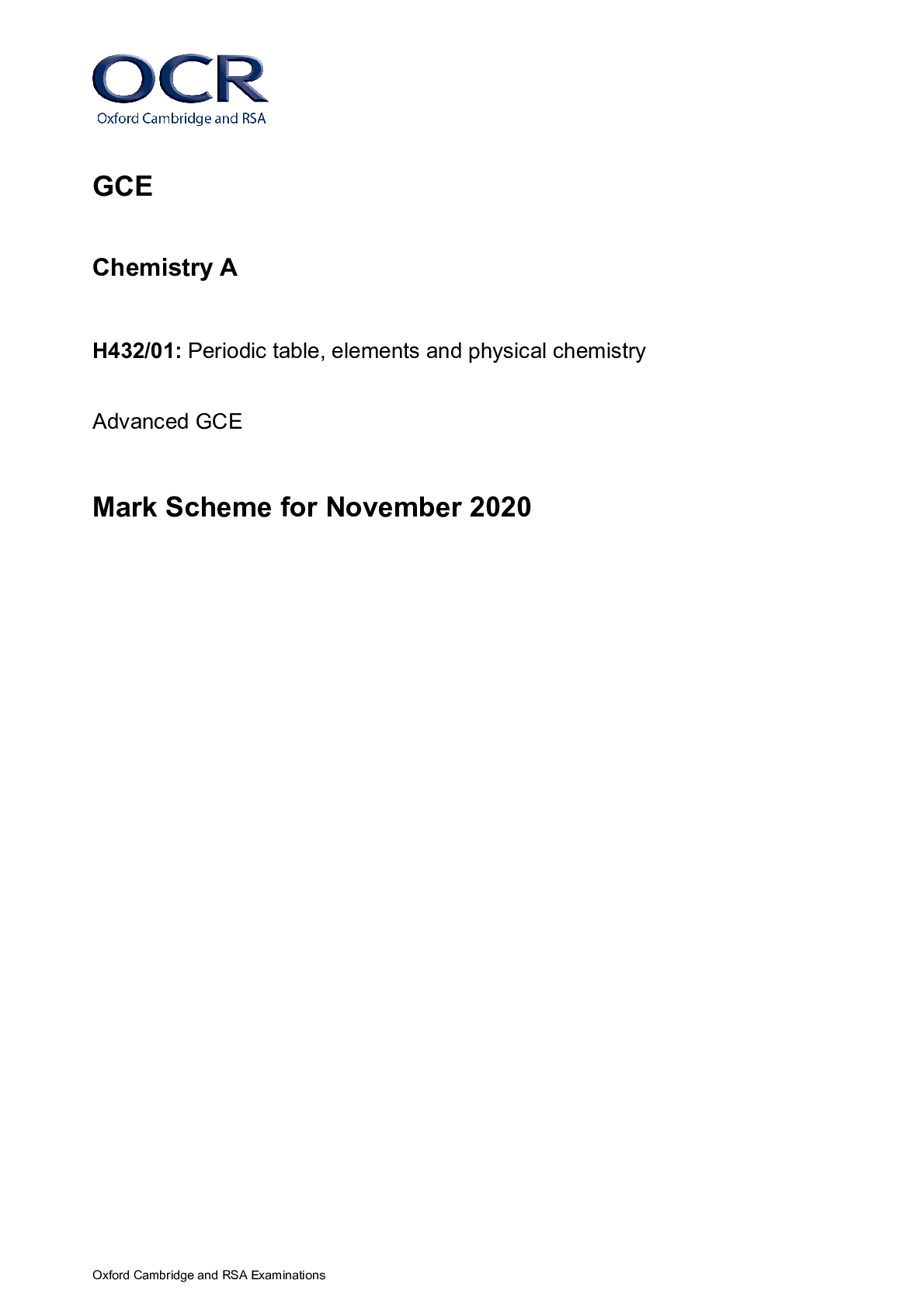
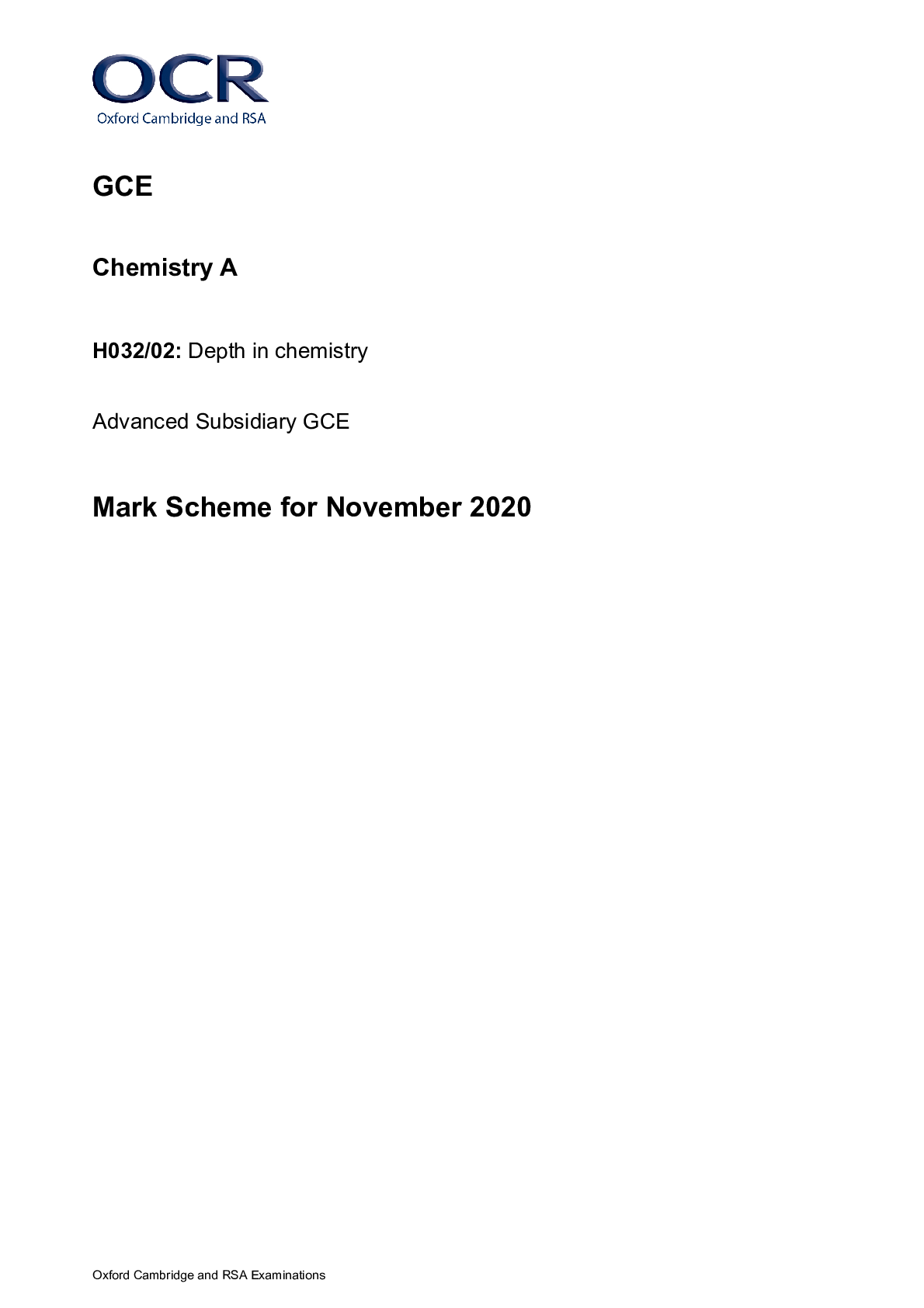

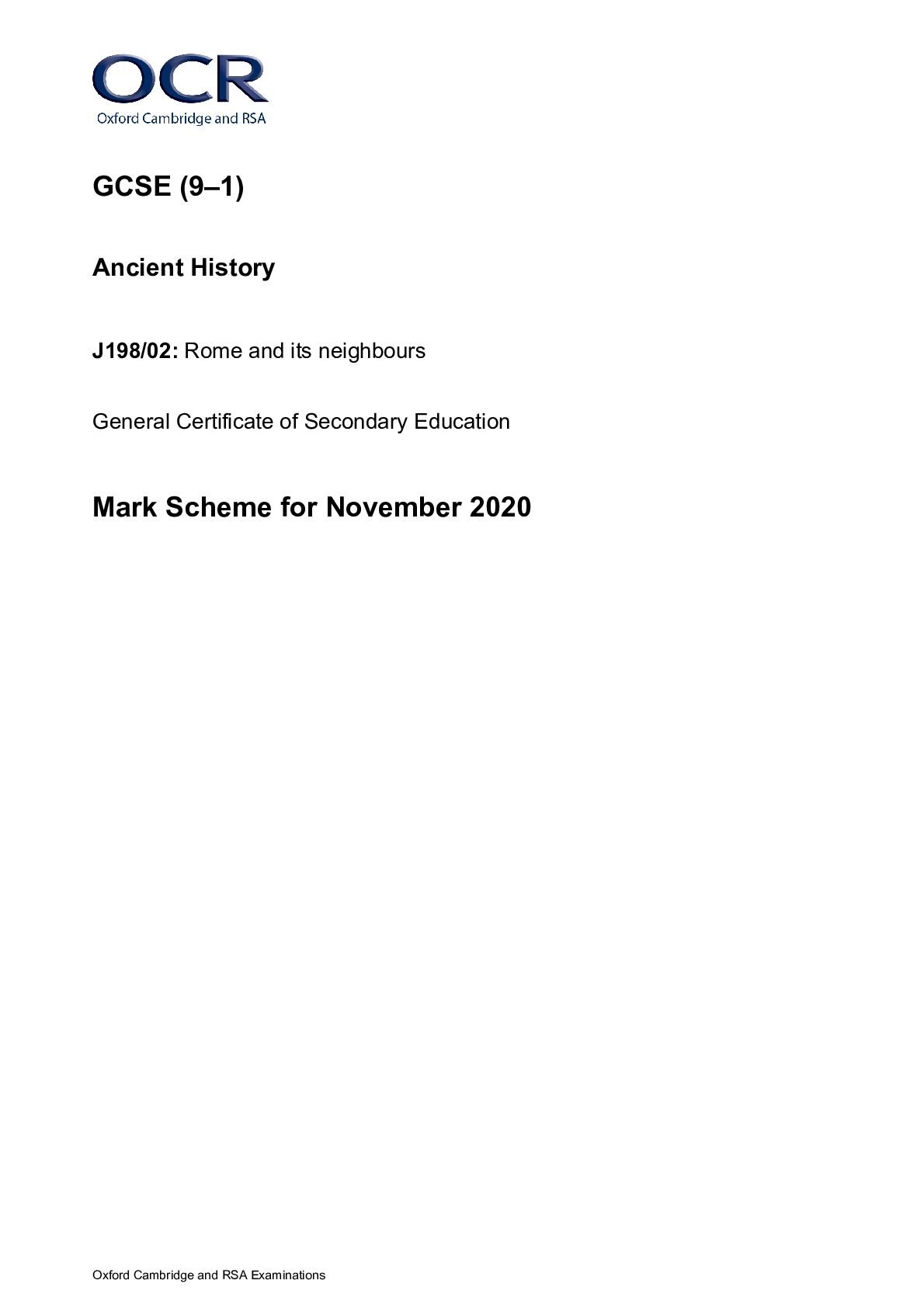




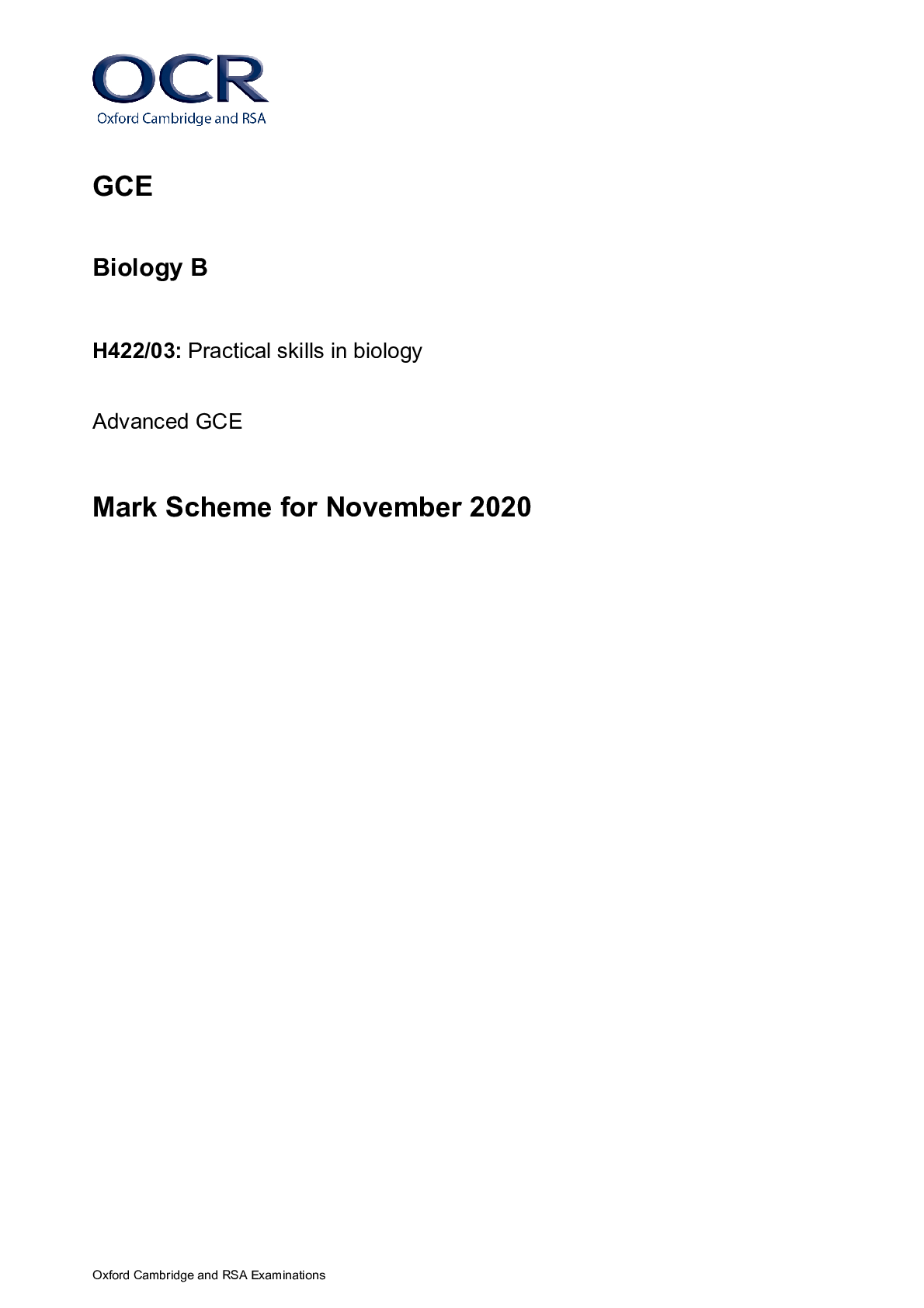
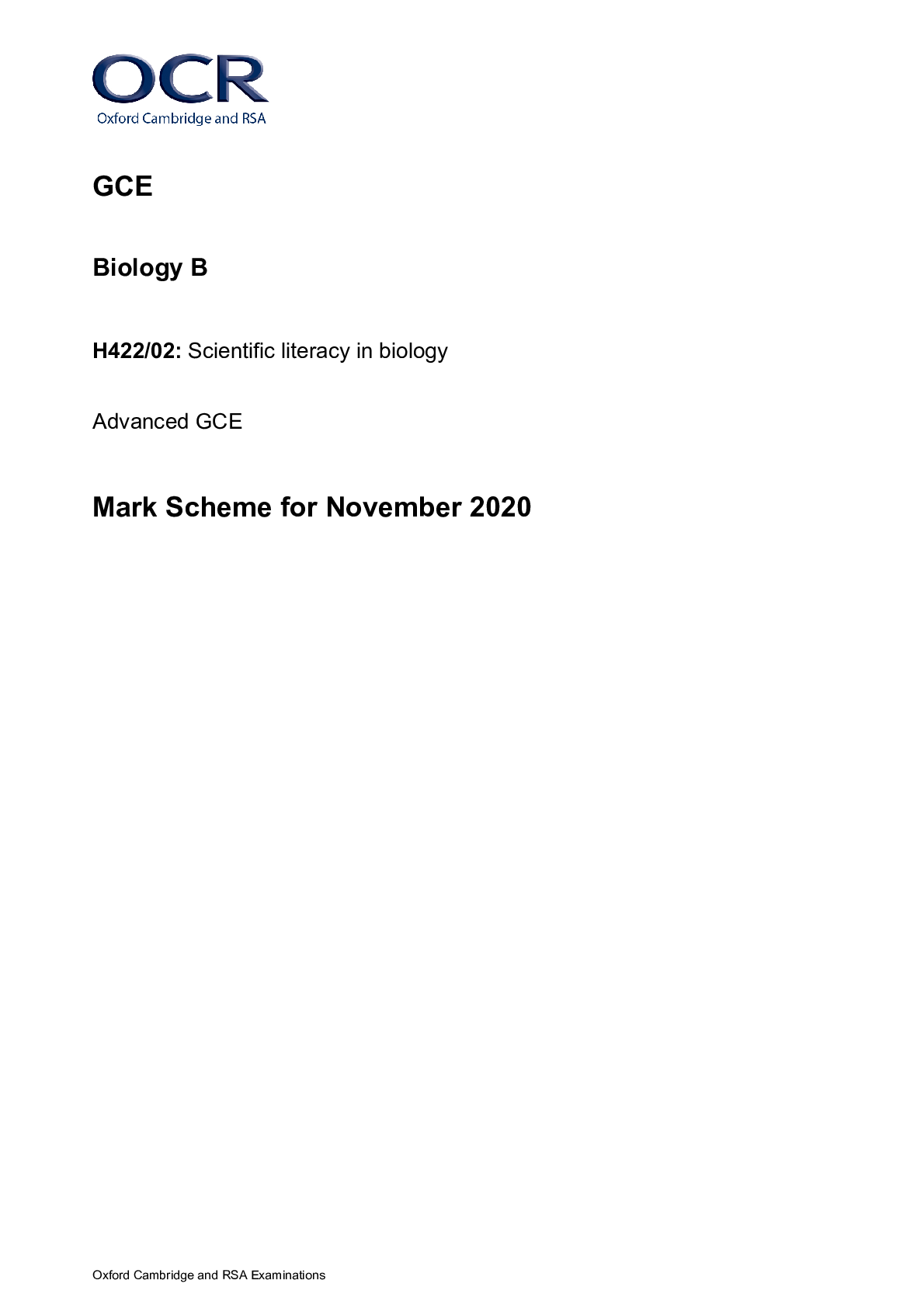
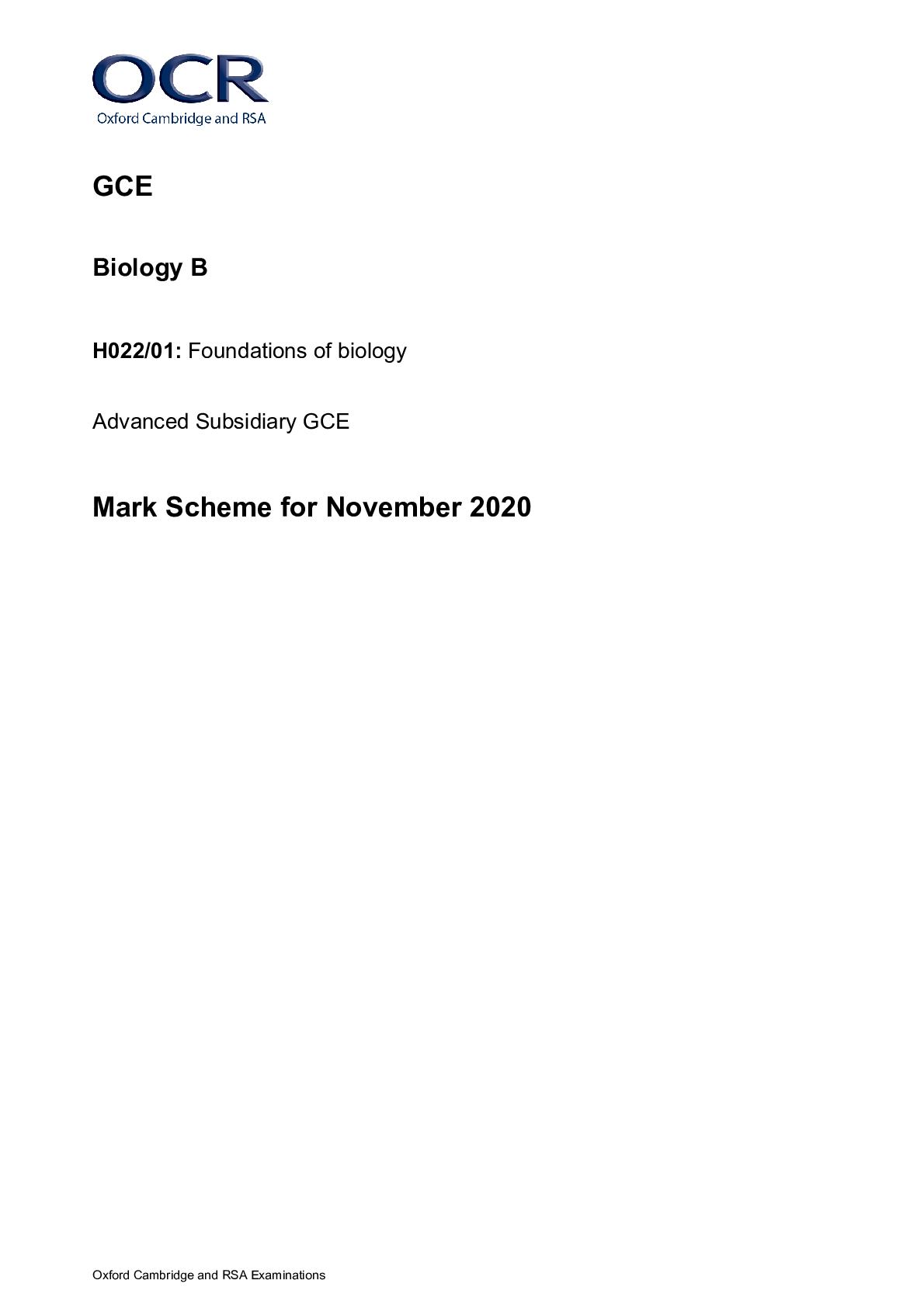

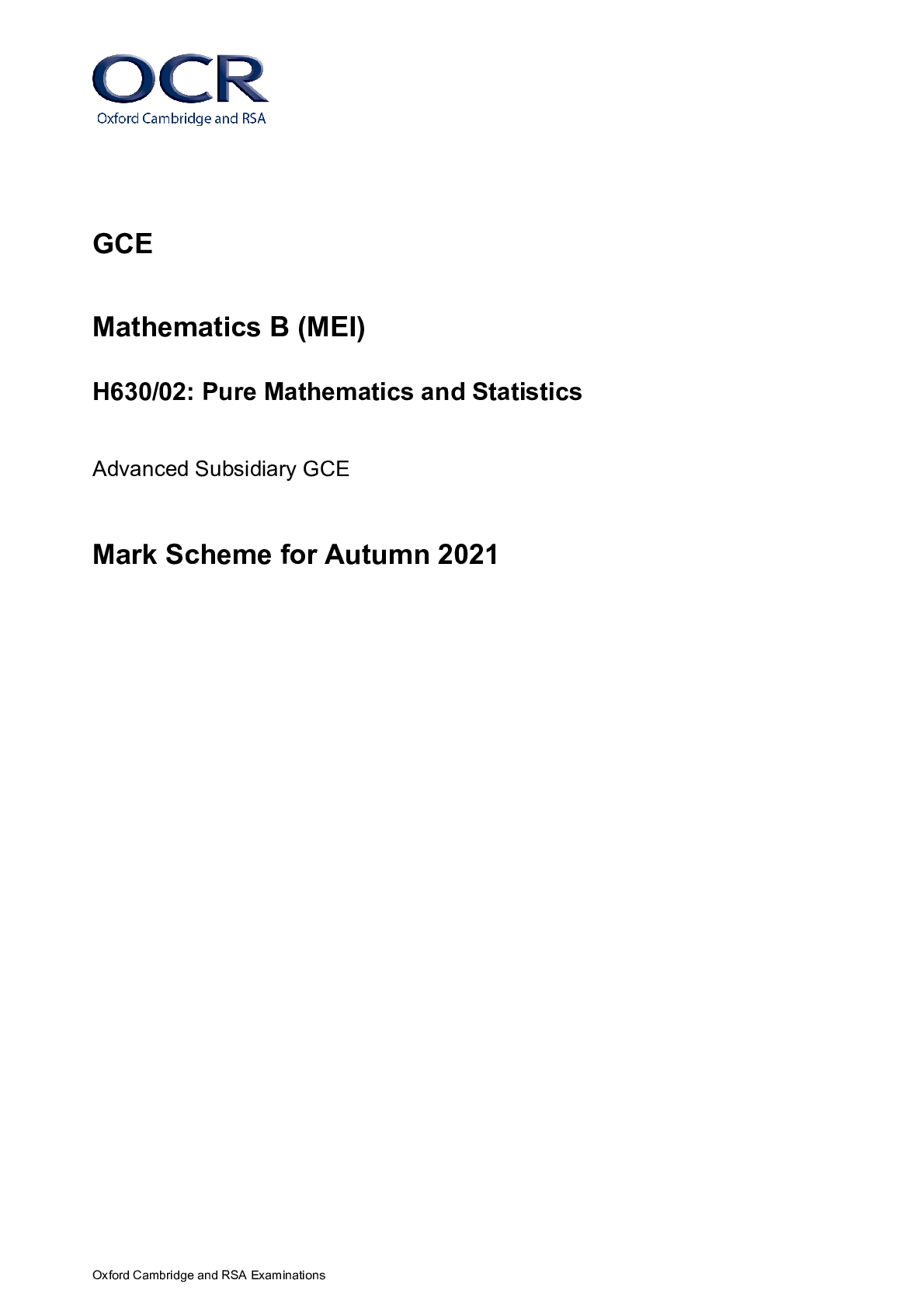


.png)
H630-02 Pure Mathematics and Statistics Advanced Subsidiary GCE Mark Scheme for Autumn 2021.png)


